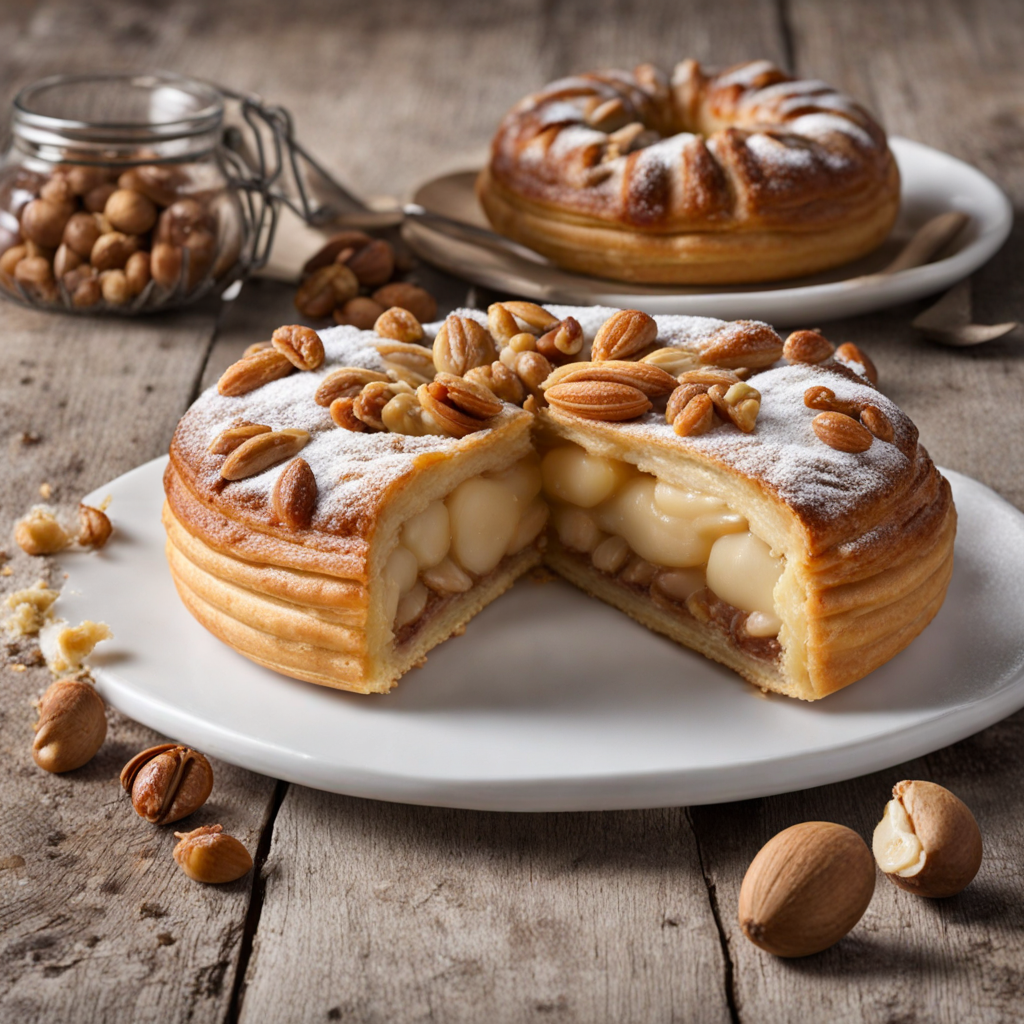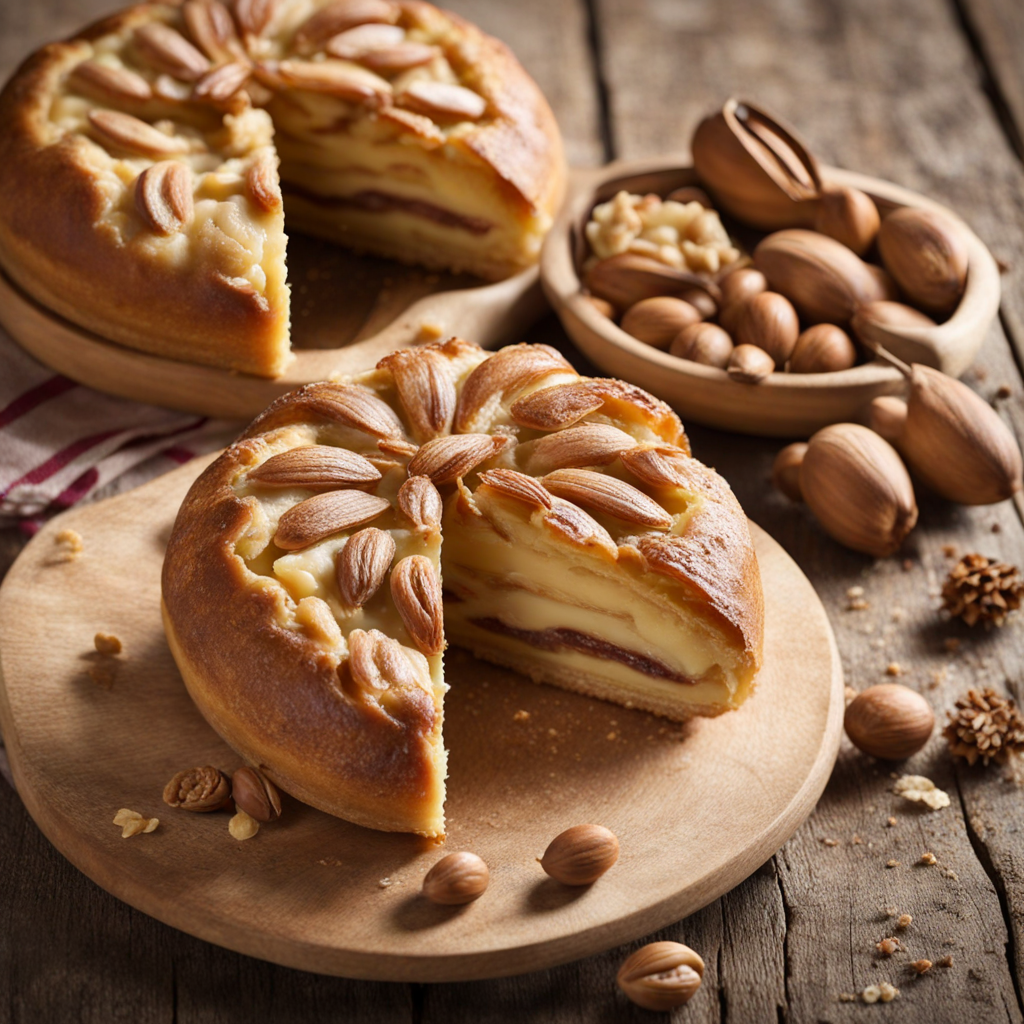Bündner Nusstorte
Bündner Nusstorte is a delectable Swiss pastry that hails from the picturesque canton of Graubünden. This delightful tart features a buttery, flaky crust that encases a rich filling made primarily of caramelized sugar, cream, and chopped nuts, typically walnuts. The combination of these ingredients creates a harmonious balance of sweet and nutty flavors, which is further enhanced by a hint of vanilla. The tart is baked to a golden perfection, giving it a slightly crisp exterior while maintaining a soft, chewy interior that melts in your mouth. The origins of Bündner Nusstorte can be traced back to the 19th century, and it has since become a cherished delicacy in Switzerland. Traditionally enjoyed as a dessert or a sweet accompaniment to coffee, this tart showcases the culinary heritage of the region and reflects the local produce, particularly the high-quality walnuts that thrive in the mountainous terrain. The dessert is often adorned with a light dusting of powdered sugar, adding an elegant touch that makes it visually appealing as well. Each bite of Bündner Nusstorte is a journey into the heart of Swiss confectionery, where simplicity meets rich flavor. Whether you savor it during a cozy afternoon tea or as a delightful end to a festive meal, this nutty tart will transport your taste buds to the enchanting landscapes of Switzerland. Pair it with a robust cup of coffee or a glass of dessert wine to elevate your tasting experience even further.
How It Became This Dish
The History of Bündner Nusstorte: A Culinary Treasure from the Heart of Switzerland Nestled in the Swiss canton of Graubünden, the Bündner Nusstorte is more than just a delectable dessert; it is a symbol of the region’s rich culinary heritage and cultural identity. This nut-filled pastry boasts a unique blend of flavors and textures that reflect the mountainous landscape and the traditions of its people. Its story is one of simplicity, ingenuity, and the enduring connection between food and culture. #### Origins: A Recipe Rooted in Tradition The origins of Bündner Nusstorte can be traced back to the 19th century, a time when Switzerland was undergoing significant changes, including the rise of tourism and the cultivation of local resources. The cake is believed to have been created around 1830 in the town of Poschiavo, located in the southern part of Graubünden. The area, known for its stunning landscapes, is also home to an abundance of walnuts, which were cultivated by the local population for centuries. Local bakers began to experiment with these walnuts, incorporating them into a sweet pie. The cake, initially a rustic treat, was made with simple ingredients: flour, butter, sugar, and eggs—the staples of Swiss baking. The addition of cream and honey added a richness that elevated the cake into a beloved dessert. The name "Bündner Nusstorte" itself reflects its origins; "Bündner" refers to the region of Graubünden, while "Nusstorte" literally translates to "nut cake." This straightforward naming underscores the cake’s humble beginnings and its deep connection to the local landscape. #### Cultural Significance: A Symbol of Graubünden Bündner Nusstorte is more than just a sweet treat; it is a cultural emblem of Graubünden and its people. The cake is often served during festive occasions, family gatherings, and community celebrations, embodying the spirit of togetherness and hospitality that is central to Swiss culture. It has become a staple in local bakeries and is frequently gifted to visitors as a token of Swiss hospitality. The cake is also featured prominently in the region's culinary festivals, such as the annual "Graubünden Cake Festival," where bakers showcase their skills and creativity by presenting their unique interpretations of the traditional recipe. This event not only highlights the significance of the cake but also fosters a sense of pride among the locals, reinforcing their connection to their cultural heritage. Over the years, the Bündner Nusstorte has been recognized as a regional specialty, enjoying Protected Geographical Indication (PGI) status since 2012. This designation helps preserve the traditional methods of production and ensures that the cake remains a true representation of Graubünden’s culinary identity. #### Development Over Time: From Rustic Beginnings to Gourmet Delight As time progressed, the Bündner Nusstorte evolved from a simple rustic dessert into a refined delicacy. The original recipe has been adapted by many local bakers, each adding their unique twist to the cake while maintaining its core elements. Some variations incorporate additional flavors, such as chocolate or spices, while others experiment with different types of nuts, showcasing the creativity and innovation of Swiss bakers. The influence of modern culinary trends has also played a role in the development of the Bündner Nusstorte. Today, many patisseries offer gluten-free or vegan versions of the cake, catering to a broader audience while still honoring its traditional roots. This adaptability has ensured that the cake remains relevant in contemporary Swiss cuisine. Moreover, the rise of artisanal baking has led to a renewed interest in traditional recipes, including the Bündner Nusstorte. Bakers are now more focused on sourcing high-quality, local ingredients, which not only enhances the flavor but also supports local farmers and producers. This movement has fostered a deeper appreciation for the cake as a symbol of sustainability and community. #### The Ingredients: A Taste of the Region At its core, the Bündner Nusstorte is a celebration of local ingredients. The primary component, walnuts, is a testament to the region's agricultural heritage. Graubünden's unique climate and soil conditions create an ideal environment for walnut trees, which thrive in the region's valleys. The nuts are typically harvested in late autumn, and their distinct flavor is a defining characteristic of the cake. The other ingredients—flour, butter, sugar, and cream—are also sourced locally when possible, reflecting the region's commitment to quality and sustainability. The use of fresh, organic products not only enhances the taste but also connects consumers to the land and its traditions. #### A Culinary Journey: Enjoying the Bündner Nusstorte Today In contemporary Switzerland, the Bündner Nusstorte is enjoyed by locals and tourists alike. It can be found in bakeries, cafés, and restaurants throughout the country, often paired with a cup of coffee or a glass of Swiss wine. The cake’s rich, buttery crust, combined with its sweet, nutty filling, makes it a perfect indulgence for any occasion. Dining establishments in Graubünden have also embraced the cake, often featuring it on their dessert menus as a nod to local traditions. Some restaurants even offer innovative twists on the classic recipe, such as serving it with a scoop of homemade ice cream or incorporating local fruits into the presentation. The cake has also garnered international attention, with food enthusiasts and chefs around the world seeking to recreate its unique flavors. Online recipes and baking blogs have helped spread the word, allowing individuals to experience a taste of Graubünden from their own kitchens. #### Conclusion: A Legacy of Flavor and Tradition The Bündner Nusstorte stands as a testament to the rich culinary heritage of Switzerland and the enduring connection between food and culture. From its humble beginnings in the 19th century to its status as a beloved regional specialty today, the cake embodies the spirit of Graubünden—a celebration of local ingredients, community, and tradition. As we savor each bite of this delightful dessert, we partake in a story that spans generations, connecting us to the land, its people, and their shared love for good food. In a world that is constantly changing, the Bündner Nusstorte remains a delicious reminder of the importance of preserving culinary traditions and embracing the flavors of our heritage.
You may like
Discover local flavors from Switzerland







